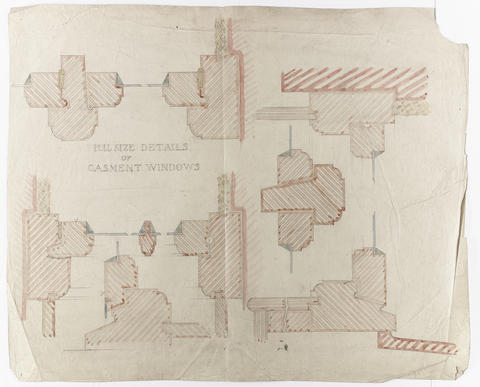License:
 This image is provided under a Creative Commons BY-NC-SA License. You can download this version for private study or non-commercial use. Our terms, conditions and copyright policy (PDF) contains further information about acceptable usage. If you are seeking permission to publish, please contact us ›
This image is provided under a Creative Commons BY-NC-SA License. You can download this version for private study or non-commercial use. Our terms, conditions and copyright policy (PDF) contains further information about acceptable usage. If you are seeking permission to publish, please contact us ›
Please click here if you would like to request a larger, high-resolution version ›
Key Information
Reference code
Title
Date(s)
- 1903-1907 (Creation)
Level of description
Item
Extent
155/188
Content and Structure
Scope and content
Full-size detail of casement windows.
Appraisal, destruction and scheduling
Accruals
System of arrangement
General Information
Name of creator
Biographical history
Thomas Johnston Beveridge was born on 15 July 1888, the son of Robertson Beveridge, (profession indeciperable) and his wife Helen Johnston. He studied at the School of Architecture, Edinburgh College of Art from 1904, receiving his diploma in July 1909. He was awarded a National Art Survey Scholarship in 1908 and a travelling bursary in 1909. He completed his training in the offices of John Kinross for whom he retained a life-long affection and shared his artistic bias and love of the Renaissance, and Sir Robert Lorimer. From 1910 to 1914 he spent time studying old work in London, Cambridge, Guildford, Hampton Court and elsewhere, and in the latter year began collecting material for his book 'English Renaissance Woodwork 1660-1730', published in 1921. In his preface he indicates the origin of this publication: 'In 1910 I found that I had the opportunity for a prolonged measuring tour. On the advice of Mr John Kinross RSA Edinburgh, I began to study the woodwork of the period of Sir Christopher Wren, with the object of publishing drawings of it in book form later on'. Several entries in the Scott Morton Letterbook of 1909 refer to Beveridge's work with Plenderleith, the firm's craftsman, on the carvings at Ardtornish, during which he must have developed an interest in fine woodwork. Beveridge was both architect and designer throughout his life.
He commenced practice on his own account in 1920, at 22 Ainslie Place, Edinburgh, and in 1924 moved to 248 West George Street, Glasgow where he specialised in domestic architecture in a Scottish traditional style. He was an assistant teacher at Glasgow School of Architecture for eight hours per week from 1928 to 1930. He was elected LRIBA in 1931, his proposers being John Watson, Thomas Lumsden Taylor and Thomas Harold Hughes.
By c1935 Beveridge had taken John Eadie Waddel Dallachy, formerly of Wylie Wright & Wylie, into partnership.
On 6 March 1939 Beveridge was elected FRIBA, his proposers being Hughes again, William Ross and Professor William James Smith. His nomination papers state that his output included ship decoration, foundry work and the design of reinforced concrete buildings, bridges etc., in association with Macdonald & Partners of Glasgow. However his obituary in the Glasgow Herald attributed Beveridge's practice with a wider range of buildings: schools, industrial estates and country houses, along with quality oak furnishings for Glasgow Cathedral and Clarence House. In his later years he worked in partnership with John Eadie Waddel Dallachy (born 1904). In 1957 he became an Associate of the RSA.
Beveridge died at the Victoria Infirmary, Glasgow on 25 July 1964. He was survived by his wife Agnes Cowan Brown.
Archival history
Custodial history
Physical Description and Conditions of Use
Conditions governing access
Conditions governing reproduction
Language of material
Script of material
Language and script notes
Physical Description
pencil and watercolour on lining paper
Dimensions: 552 x 675 mm
Finding aids
Related Material
Existence and location of originals
Existence and location of copies
Related materials
Notes area
Alternative identifier(s)
Keywords/Tags
Subjects
Place access points
People and Organisations
Genre access points
Status
Level of detail
Processing information
Language(s)
Script(s)
Sources
Digitised item metadata
Filename
NMC_0908_0155.jpg
Latitude
Longitude
Media type
Image
Mime-type
image/jpeg


